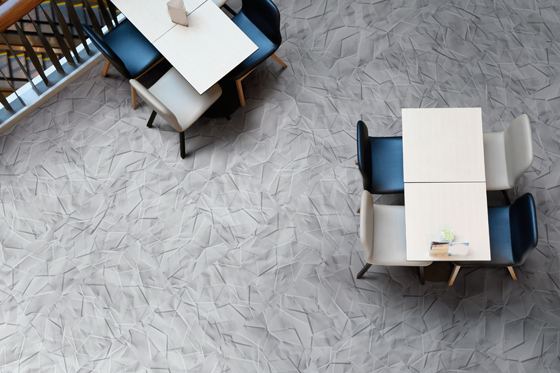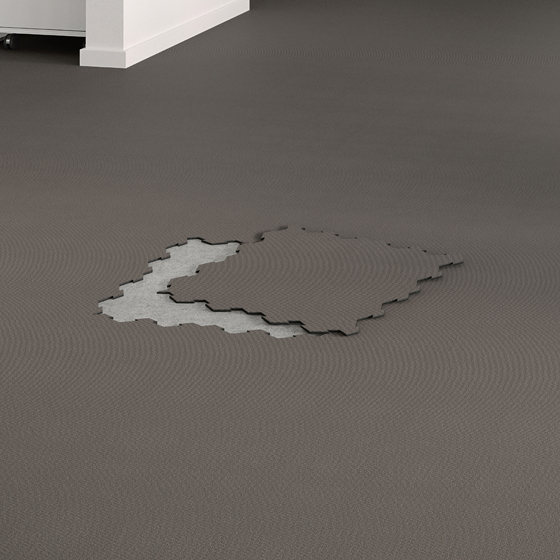Run for cover: Trends at Domotex 2018
Texte par Domotex
Hannover, Allemagne
19.12.17
Print technologies for creating unique products, sound-absorbing designer flooring, super-fluffy textured carpets and the rediscovery of herringbone parquet: sustainability is the universal aspect uniting the new flooring designs at DOMOTEX 2018.
Urban Jungle: auditorium of a company’s headquarters in Taipei, designed by MVRDV in collaboration with Argentinian carpet designer Alexandra Kehayoglou. Photo: © MVRDV
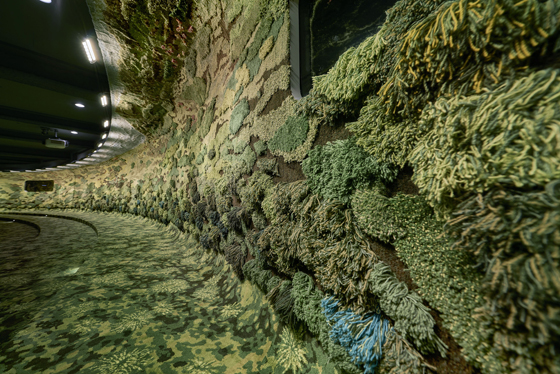
Urban Jungle: auditorium of a company’s headquarters in Taipei, designed by MVRDV in collaboration with Argentinian carpet designer Alexandra Kehayoglou. Photo: © MVRDV
×So Flooring can be as unique as the individual user. That’s why, for 2018, DOMOTEX has chosen UNIQUE YOUNIVERSE as the exhibition’s keynote theme: it’s all about products and services that can be customised. In architecture, one can find many current examples where floor covering plays the main role. For example, in collaboration with Argentinian artist Alexandra Kehayoglou, the Dutch architectural studio MVRDV has covered the surfaces of a presentation room at the headquarters of a Taipei-based company with moss-green carpet. Featuring a camouflage pattern and different pile heights, the bespoke carpet is reminiscent of a meadow and not only covers the floor, but also the walls and the ceiling.
The future will be individual
At DOMOTEX, too, visitors will be able to experience such a gesamtkunstwerk in Hall 9: for Classen, Munich-based designer Konstantin Landuris will project Ludwig Mies van der Rohe’s famous Barcelona Pavilion into the future. The project will not only feature elements from space travel, for example a sleeping pod, but also a designer floor covering boasting a bespoke zigzag print pattern, especially produced for this installation by Classen in collaboration with Landuris. The floor covering is representative of Classen’s innovation: using cutting-edge technology at the company’s location in Niederesch, bespoke patterns designed by customers can be digitally printed onto the flooring.
The time where there used to be only one universal trend, one colour, one style and one new technology has long gone. We live in an era of diversity, of sampling and of eclecticism. Digital tools like smartphones, virtual reality, the Internet of Things, cloud-based working, voice control and 3D printing are driving us towards the future.
Anthropogenic climate change, however, confronts us with a totally different, enormous challenge: organising our lives and economies in a sustainable way, in harmony with nature. These are challenging developments – developments that also affect flooring, since it is an integral part of everyday life.
Today, floor covering manufacturers cannot afford not to have sustainable products in their portfolios. At the forthcoming DOMOTEX, sustainability will also play a major role. In particular, designer flooring (still the segment with the largest growth rate) is now catching up with this trend.
Bespoke digital printing: Konstantin Landuris has designed a designer flooring in collaboration with Classen. Photo: © Konstantin Landuris
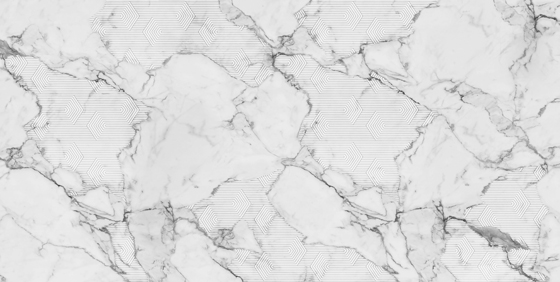
Bespoke digital printing: Konstantin Landuris has designed a designer flooring in collaboration with Classen. Photo: © Konstantin Landuris
×Now with sound-absorbing properties: Korlok designer flooring from Designflooring. Photo: © Designflooring
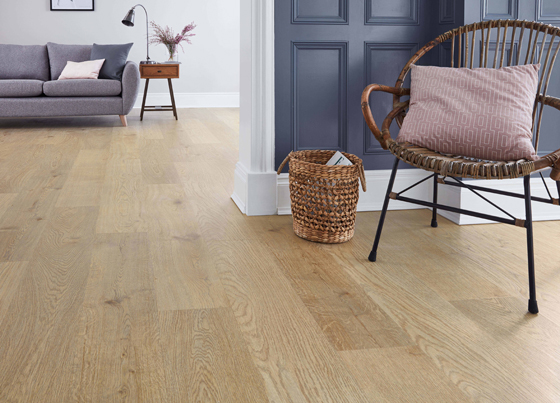
Now with sound-absorbing properties: Korlok designer flooring from Designflooring. Photo: © Designflooring
×Natural materials for designer flooring
For its Purline Bioboden designer flooring brand, Windmöller will be introducing a new collection in Hannover, created in particular for the contract business, with qualities such as high stability and simple installation and maintenance. Ninety percent of the materials used for Purline are obtained from natural resources such as castor oil, rapeseed oil and chalk, while chlorine compounds, softening agents or solvents are being avoided.
The holy grail for designer flooring, however, is still the substrate: perfecting aspects relating to thermoplastic expansion, the telegraphy effect (where imperfections in the substrate show in the covering) and other functions important in commercial applications is the order of the day for all manufacturers. Sound absorption, in particular, is seen by many suppliers as an added value, delivered, for example, by the new Korlok hard covering from Designflooring that features an integrated acoustic foam layer. Looking at the new patterns, one can see that a lot is going on in designer flooring: geometrical patterns, texture and mosaic styles like, for example, the new Expona Domestic collection by Objectflor, are alternatives to existing wood and stone looks.
Dynamic floor: geometrical patterns for invigorating experiences. Photo: © Objectflor
New look for a classic pattern: herringbone now also features in designer flooring; example: Objectflor. Photo: © Objectflor

New look for a classic pattern: herringbone now also features in designer flooring; example: Objectflor. Photo: © Objectflor
×Herringbone parquet makes a comeback
Rustic country house-style surfaces and vintage looks continue to set the tone in the real-wood segment. The point is to improve the tangible qualities of flooring, says Ter Huerne. For the new season, with its Unique collection, the parquet specialist is placing even greater emphasis on hand-finished surfaces. There is a general demand for natural and warm shades in parquet, alongside an ongoing trend for Scandinavian-style limewashed surfaces. Additionally, according to Ter Huerne, herringbone parquet is making a comeback. And, although parquet is a natural material, sustainability is an important aspect here too: for example, by using wood from sustainable, regional forestries or finishing oils made from natural resources like walnuts. At Ter Huerne, healthy home environments are a top priority.
Rustic country home charm: large floorboards with visible grain lines continue to be trumps in the parquet segment. Photo: © Ter Huerne
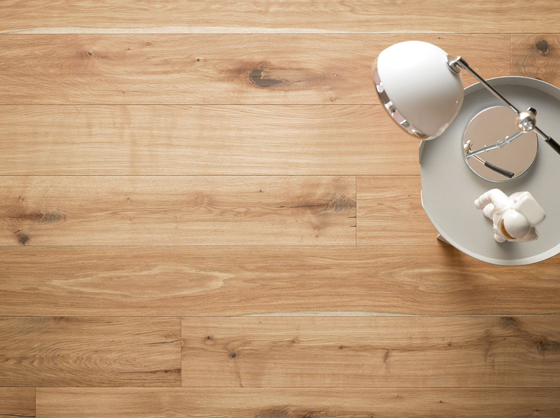
Rustic country home charm: large floorboards with visible grain lines continue to be trumps in the parquet segment. Photo: © Ter Huerne
×Patented jigsaw puzzle: the new LockTiles from Danish carpet manufacturer Fletco. Photo: © Fletco
Carpet tiles reminiscent of jigsaw pieces
There’s also movement in the carpet segment: latest developments show that carpet tiles can be combined, in creative and, above all, seamless ways, with designer flooring planks. Furthermore, tile formats that make installation easier and improve surface homogeneity will also premiere in Hannover: with its square LockTiles, featuring zigzag laser-cut edges, Fletco will be introducing a new product reminiscent of jigsaw pieces. Here, too, sustainability has been taken into account with 60 percent of the backing of Fletco products coming from recycled materials and with CO2-neutral production including 100 percent use of wind energy.
Carpets bringing hygge into the home
Thanks to their textile qualities and their high colour brilliance, carpets can be an essential element in the overall interior architecture: a role that they are slowly regaining because carpets communicate a feeling of warmth and homeliness, or hygge, as it’s called in Danish. For those who opt for a carpet, it’s a statement decision accentuated by dynamic, coarse textures or by soft and super-fluffy velour made from natural materials like silk and wool, explains Andreas Tischhauser from Swiss carpet specialist Tisca.
Tischhauser also provides an outlook of what we can expect to see in the Tisca colour palette at DOMOTEX 2018: alongside pastel shades in the powder and rose gamut and in addition to new greens and blues, “Urban Jungle” focuses on the theme of nature that will certainly not only feature at Tisca. Patterns from nature, accentuated with natural earthy and green shades bring the natural environment into the home – the offering by MVRDV from Taipei being a prime example. Going by the name of ‘biophilic design’ it’s a universal trend that, together with indoor gardening and green facades is coming to our homes and cities.
Textile craftsmanship and coarse textures are tops: Salsa Tonga range from Paulig. Photo: © Paulig
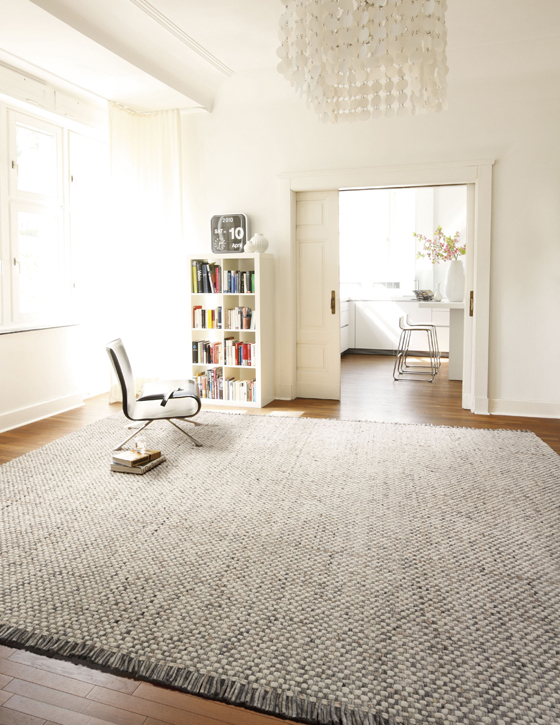
Textile craftsmanship and coarse textures are tops: Salsa Tonga range from Paulig. Photo: © Paulig
×Top marks in sustainability: Tisca’s GOTS-certified Respect collection uses plant-based dyes. Photo: © Tisca
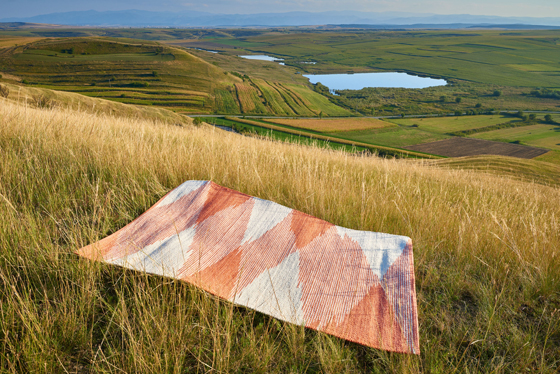
Top marks in sustainability: Tisca’s GOTS-certified Respect collection uses plant-based dyes. Photo: © Tisca
×Traditional textile techniques
The fact that textile crafts and traditions have become extremely popular is expressed – obviously – in hand-knotted and hand-woven rugs. Paulig, for example, will be showing designs for its Haro brand that feature traditional woven textures achieved by adding modern know-how. Tisca from Austria will be bringing its Respect collection that uses plant-based dyes, the first GOTS-certified carpet collection, created in collaboration with Swedish designer Anneli Tegelberg. For the ikat pattern, the yarn is dyed section by section before it is woven.
Irregular knotting, ruffled piles with different heights, randomly distributed dots: ‘perfect imperfection’ runs like a common thread through the entries to the Carpet Design Awards. The theme highlights the fact that products are not only made by machines but also, or indeed entirely, by human hands. In a time when we are increasingly seeing smooth, high-tech surfaces, we long for real and tangible experiences. As Anni Albers, head of the weaving workshop at the Bauhaus put it: “We touch things to assure ourselves of reality. We touch the things we form. Our tactile experiences are elemental. If we reduce their range, we grow lopsided.”




